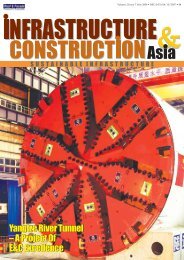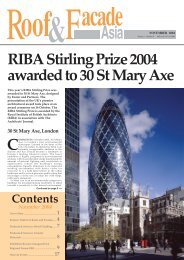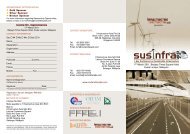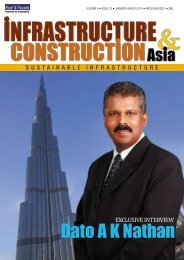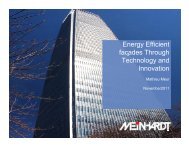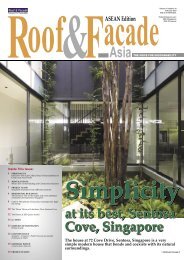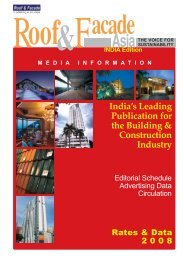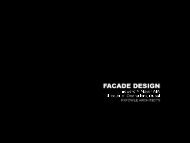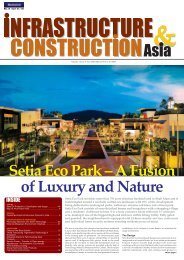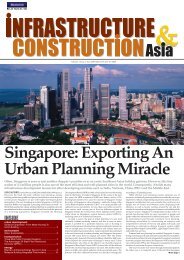Architecture for Athens 2004 - Roof & Facade
Architecture for Athens 2004 - Roof & Facade
Architecture for Athens 2004 - Roof & Facade
Create successful ePaper yourself
Turn your PDF publications into a flip-book with our unique Google optimized e-Paper software.
<strong>Roof</strong>&<br />
<strong>Facade</strong><br />
Asia<br />
OCTOBER<br />
<strong>2004</strong><br />
Volume 1 Number 8 MITA (P) 295/11/2003<br />
<strong>Architecture</strong> <strong>for</strong><br />
<strong>Athens</strong> <strong>2004</strong><br />
THE facilities <strong>for</strong> the <strong>2004</strong> Olympic<br />
Games and Paralympic Games in<br />
<strong>Athens</strong>, Greece, designed by the<br />
world-famous architect, Santiago<br />
Calatrava, stood out <strong>for</strong> their<br />
innovative structural <strong>for</strong>ms,<br />
especially the roofing systems.<br />
The Wall of Nations.<br />
© ATHOC/ Photo credit: C. Cunliffe.<br />
Facilities <strong>for</strong> <strong>2004</strong><br />
Olympic Games and<br />
Paralympic Games<br />
Tarchitect, to redesign the <strong>Athens</strong> Olympic<br />
HE Organising Committee <strong>for</strong> the Olympic<br />
Games <strong>Athens</strong> <strong>2004</strong>, in a joint ef<strong>for</strong>t with the<br />
Ministry of Culture in Greece, chose Dr<br />
Santiago Calatrava, the renowned Spanish<br />
Sports Complex (OAKA) and to carry out a series of other<br />
architectural works in the city of <strong>Athens</strong>.<br />
Combining, within a modern context, the<br />
environment, history and culture of Greece, particularly<br />
the spirit of the Olympic movement, Dr Calatrava has<br />
created a work of art that has left a permanent mark on<br />
contemporary <strong>Athens</strong>.<br />
Perhaps the identity of both the <strong>2004</strong> Games and the<br />
city of <strong>Athens</strong> is best reflected in the design OAKA.<br />
Key features of Dr Calatrava’s design include the<br />
suspended arches which partially cover the Olympic<br />
Stadium, the Velodrome and the entrances leading to the<br />
Continued on page 2 >>><br />
Contents<br />
October <strong>2004</strong><br />
Cover Story ................................................. 1<br />
Feature: Natural Stone Applications ....... 6<br />
Products & Services: Paints &<br />
Coatings ..................................................... 8<br />
Products & Services: Waterproofing .... 11<br />
Products & Services: Curtain Wall ....... 13<br />
News & Events ........................................16
<strong>Roof</strong>&<strong>Facade</strong> Asia Cover Story: <strong>Architecture</strong> <strong>for</strong> <strong>Athens</strong> <strong>2004</strong><br />
>>> Continued from page 1<br />
OAKA area. A semicircle is created between the<br />
competition venues, providing the same cover <strong>for</strong> the<br />
sponsors’ hospitality venue, the restaurants and the shops<br />
at the Games.<br />
In the post-Olympic era, the same area can host major<br />
events and exhibitions.<br />
Further, the Tower of the Olympic Flame was placed<br />
in a central square, in such a way that it was visible from<br />
each and every competition venue.<br />
Dr Calatrava’s skill in bringing design and<br />
engineering elements together in an innovative and<br />
creative way is reflected in his design <strong>for</strong> the OAKA.<br />
The paved central axis (the boulevard) which runs<br />
from east to west, provides a direct connection to the<br />
various Olympic venues.<br />
Suspended arched roofs partially cover the Olympic<br />
Stadium (the location <strong>for</strong> the opening and closing<br />
ceremonies, track and field events and the men’s soccer<br />
final) and the entrances, and fully cover the Velodrome<br />
(the location <strong>for</strong> the indoor cycling events). At the Arcade,<br />
curved shell structured steel arches and top cladding<br />
provided shade <strong>for</strong> spectators while allowing sunlight<br />
in.<br />
Indigenous vegetation was planted inside and outside<br />
the OAKA, while decorative water pools with light blue<br />
surfaces illuminated at night, enhanced the natural,<br />
relaxed atmosphere of the Games.<br />
Promenade areas with marble lanes, ponds and lightstreams<br />
completed the synthesis of the Agora.<br />
The Olympic Stadium.<br />
© ATHOC/ Photo credit: C. Voulgari.<br />
The Olympic Stadium<br />
In accordance with the architectural study per<strong>for</strong>med by<br />
Santiago Calatrava, the newly built roof partially covers<br />
the Olympic Stadium, mainly the terraces, over a total<br />
area of 25,000 sq m.<br />
The bearing construction is made of two double steel<br />
arcs which are positioned at the same height in pairs, and<br />
connected with extended cables. A system of diagonal<br />
connectors further strengthens the structure.<br />
The construction is completed with transverse girders<br />
which are connected to the lower arc and <strong>for</strong>m a grid on<br />
which polycarbonate was installed.<br />
The Velodrome<br />
The Olympic Velodrome is fully covered with a structure<br />
similar to the roof of the Olympic Stadium, with a steel<br />
bearing structure, the central zone of which is covered<br />
with solar controlling laminated glass and the rest with<br />
aluminium panels. The inner surface of the roof is lined<br />
with wooden panels.<br />
The Entrance Canopies<br />
The entrance canopies provided visitors with their first<br />
and final impressions of the complex. Spectators were<br />
able to clearly identify the Sports Complex OAKA by its<br />
glazed canopies which consist of steel structures<br />
supported by steel arches and topped with laminated<br />
glass.<br />
The Agora<br />
The Agora is a multi-purpose space which dominates the<br />
OAKA public areas, and comprises two main areas - the<br />
square and the arched promenade which provides shade<br />
<strong>for</strong> the public and at the same time, acts as a connective<br />
element between venues.<br />
The arched promenade consists of a series of steel<br />
arches, between which white wooden beams are placed.<br />
The roof provides shade and creates a pleasant<br />
atmosphere.<br />
The Wall of Nations<br />
The Wall of Nations is a huge sculptural creation made<br />
from steel tubes. These are motorised and can move in a<br />
wave-like manner. RnF<br />
The Olympic Stadium.<br />
© ATHOC/ Photo credit: C. Cunliffe.<br />
The Agora.<br />
© ATHOC/ Photo credit: G. Prinos.<br />
2 <strong>Roof</strong> & <strong>Facade</strong> Asia • October <strong>2004</strong>
Cover Story: <strong>Architecture</strong> <strong>for</strong> <strong>Athens</strong> <strong>2004</strong><br />
<strong>Roof</strong>&<strong>Facade</strong> Asia<br />
The Olympic Velodrome.<br />
© ATHOC/ Photo credit: C. Cunliffe<br />
<strong>Roof</strong> & <strong>Facade</strong> Asia • October <strong>2004</strong> 3
<strong>Roof</strong>&<strong>Facade</strong> Asia Cover Story: <strong>Architecture</strong> <strong>for</strong> <strong>Athens</strong> <strong>2004</strong><br />
A polycarbonate roof <strong>for</strong> the Olympic Stadium<br />
THE Olympic Stadium in <strong>Athens</strong>, named after Spyridon Louis, the Greek<br />
winner of the Marathon at the first modern Olympic Games in <strong>Athens</strong> in<br />
1896, was the venue of the Opening and Closing Ceremonies, all the track<br />
and field events and the men’s soccer final, at the <strong>2004</strong> Olympic Games.<br />
The roof of the arena, called the Calatrava Dome, can already claim three<br />
world records. It is not only the biggest stadium roof in the world, it is also<br />
the largest transparent roof ever built. Thirdly, it is the biggest roof ever to<br />
have been placed on top of a stadium after the stadium was completed.<br />
The roof sections are made of solid, highly transparent plastic sheets of<br />
MAKROLON polycarbonate from Bayer MaterialScience AG. The bluish<br />
shining panels provide <strong>for</strong> a friendly, open and bright atmosphere in the<br />
arena, and made it possible <strong>for</strong> the spectators to gaze up into the Greek<br />
summer sky.<br />
The roof is a dynamic suspension structure, defined by two metal arches,<br />
each 300 m long, with their apex rising to a height of 78 m. The arches span<br />
the stadium in the longitudinal direction and each carry a dome suspended<br />
on double-arch supports. In total, the roof structure weighs 17,000 tons,<br />
covers an area of nearly 25,000 sq m and can protect up to 75,000 spectators<br />
from direct sunshine and rain.<br />
Wire cables are connected to the two large metal arches, and it is to these<br />
that the 12 mm thick, nearly 5 m long and 1 m wide polycarbonate sheets<br />
are fixed. Sheets made of MAKROLON were chosen not only because of its<br />
high transparency but also on account of its lower weight when compared<br />
with that of glass. The sheets weigh just 14.4 kg/sq m. The favourable statics<br />
provided the architect with greater design scope.<br />
A special additive in the plastic kept the spectators cool despite the<br />
summer heat. This additive reflects the majority of the radiant heat from<br />
natural sunlight, but still allows the visible part of the light to pass through.<br />
As a result, the air mass in the stadium did not heat up as much. Another<br />
advantage of the plastic sheets, which have additionally been given a<br />
scratchproof finish, is their machinability. They can be sawed, drilled and<br />
cut without any problem. They do not break, which, together with their<br />
low weight, made handling during assembly much easier.<br />
Equally impressive was the procedure used <strong>for</strong> the construction of the<br />
stadium. So as not to interrupt the building work, the two halves of the<br />
roof were assembled separately next to the stadium. Once the main bulk of<br />
the work in the stadium had been concluded, the two 8,500 ton structures<br />
were each manoeuvred hydraulically on to the stadium on sliding blocks,<br />
using a special track-mounted system. Finally, the polycarbonate sheets were<br />
bolted into place. RnF<br />
Enquiry No: 10/101<br />
The world record-breaking Calatrava Dome is a roof of dynamic suspension structure, defined by two metal arches.<br />
<strong>Roof</strong>ing <strong>for</strong> the Stadium of<br />
Peace and Friendship<br />
THE Stadium of Peace and Friendship is located about<br />
25 km from the Olympic Village, in the Faliro Coastal<br />
Zone Olympic Complex, south of <strong>Athens</strong>.<br />
The venue <strong>for</strong> the volleyball matches at the <strong>2004</strong><br />
Olympic Games has a concave-shaped roof that offered<br />
protection to the approximately 14,000 spectators and<br />
players, from the extreme summer heat.<br />
Further, since the roof was supported solely by pillars<br />
at its perimeter, television viewers and spectators alike,<br />
were provided with an unobstructed view of the<br />
volleyball court.<br />
However, since the 35 m high stadium is located<br />
directly at the harbour, it is subject to the torrid heat in<br />
summer and the near-freezing temperatures in winter,<br />
varying wind strengths and salt-laden air.<br />
Sarnafil TS 77-15 - RAL 7040, a flexible polyolefin<br />
from Sarnafil, was used in the refurbishment of the<br />
existing roof, due to its special <strong>for</strong>mulation and the fact<br />
that it does not contain any plasticiser. The product has<br />
good chemical resistance, even at higher temperatures.<br />
These characteristics were decisive <strong>for</strong> the Greek<br />
contractors, since protection of the stadium needed to<br />
be long-term. Sarnafil-trained installers passed on<br />
expertise and knowledge to their Greek counterparts, a<br />
step that was crucial to the completion of the enormous<br />
installation. Together, they covered a surface as large as<br />
two soccer pitches.<br />
Sarnafil was also involved in building the<br />
Beach Volleyball Centre and other stadiums <strong>for</strong> the<br />
Games. RnF<br />
Enquiry No: 10/102<br />
The Stadium of Peace and Friendship: The concave-shaped roof offered protection to the spectators and players from the extreme summer heat.<br />
4 <strong>Roof</strong> & <strong>Facade</strong> Asia • October <strong>2004</strong>
Cover Story: <strong>Architecture</strong> <strong>for</strong> <strong>Athens</strong> <strong>2004</strong><br />
<strong>Roof</strong>&<strong>Facade</strong> Asia<br />
<strong>Roof</strong>ing structures completed by<br />
Taiyo Membrane Corporation<br />
The Karaiskaki Stadium (on top), with a capacity to seat 33,000 spectators, and the two tension membrane entrance structures, at the <strong>Athens</strong> Olympic Sports<br />
Complex (above left and right).<br />
THE 28,000 sq m, white coloured, membrane roof <strong>for</strong> columns, special red-white night lighting, and red laser<br />
Karaiskaki Stadium in <strong>Athens</strong>, which was the venue <strong>for</strong> beams to project the Olympaikos emblem in the middle<br />
the soccer matches at the <strong>2004</strong> Olympic Games, was of the field, augment the club colours <strong>for</strong> the stadium.<br />
engineered and manufactured by Taiyo Membrane TMC also completed two tension membrane entrance<br />
Corporation (TMC).<br />
structures at the <strong>Athens</strong> Olympic Sports Complex. Each<br />
After the Olympics, the stadium, which has the structure used approximately 500 sq m of Mehler FR900<br />
capacity to seat 33,000 spectators, will be the home PVC membrane. RnF<br />
stadium <strong>for</strong> the Olympaikos league team.<br />
Fourteen red towers, 70 white intermediate steel Enquiry No: 10/103<br />
<br />
<br />
<br />
<br />
<br />
<br />
<br />
<strong>Roof</strong> & <strong>Facade</strong> Asia • October <strong>2004</strong> 5
<strong>Roof</strong>&<strong>Facade</strong> Asia<br />
Feature: Natural Stone Applications<br />
The use of stone in curtain walls<br />
[This is an edited excerpt from a publication produced by Internazionale Marmi e Macchine<br />
Carrara SpA (IMM). Well-known all over the world <strong>for</strong> the promotion of marble and other<br />
stone materials, IMM has, over the last few years, expanded its range of activities. The<br />
company’s objective is to acquaint people with the qualities of stone and all its possible uses].<br />
Introduction<br />
The use of thin stone in curtain wall systems<br />
is becoming more widespread in Europe.<br />
Aside from their traditional structural<br />
function, stone materials are now being recognized<br />
<strong>for</strong> characteristics which compare<br />
favourably with those of many other building<br />
materials used <strong>for</strong> cladding purposes.<br />
These include aesthetic qualities; the ability<br />
of the stone to act as a barrier to prevent<br />
atmospheric and polluting elements from<br />
entering the internal environment; the minimal<br />
requirement <strong>for</strong> maintenance or renovation;<br />
their capacity to increase the degree<br />
of internal com<strong>for</strong>t, thanks to the possibility<br />
of creating ventilated curtain wall systems;<br />
and their ability to provide greater<br />
sound reduction in lightweight cladding<br />
systems, due to the mass of the materials.<br />
In order to exploit the above characteristics<br />
and maintain adequate safety levels, especially<br />
in the use of thin stone <strong>for</strong> large<br />
buildings subjected to adverse environmental<br />
conditions, the important considerations<br />
include the correct choice of stone, the accurate<br />
design of stone fixing systems, and<br />
the accurate installation of stone.<br />
Criteria in the choice of stone<br />
<strong>for</strong> cladding<br />
As the use of stone <strong>for</strong> cladding purposes<br />
is a solution <strong>for</strong> the lifespan of the<br />
building, the choice of the stone should<br />
be on the basis of technical and design<br />
aspects. These apply both generally and<br />
in the specific case of curtain wall systems.<br />
Architectural and aesthetic factors will<br />
determine the initial selection of the stone.<br />
These are dependent upon the vein<br />
patterns and/or grains; the extensive<br />
colour spectra; the proposed cladding<br />
layout which divides units into various<br />
shapes and sizes; and the surface finishes<br />
which best enhance the inherent aesthetic<br />
qualities of the cladding.<br />
The main factors determining the ultimate<br />
choice of stone include the production<br />
technology available <strong>for</strong> processing stones,<br />
the chemical-physical properties of the<br />
stones and their suitability under the environmental<br />
conditions at the location of the<br />
project, the mechanical properties of the<br />
stones and whether they will enable the material<br />
to withstand the stresses caused by the<br />
load conditions and the fixing systems used,<br />
and the total cost of the cladding.<br />
Stone fixing systems<br />
After completing the theoretical and practical<br />
tests to assess the quality and chemicalphysical-mechanical<br />
properties of the stone<br />
materials selected, and after taking into account<br />
the architectural design of the cladding<br />
and the environmental and loading<br />
conditions, it is necessary to select the most<br />
suitable stone fixing system.<br />
This involves the study of the design and<br />
distribution of the various notches possible,<br />
to accommodate the mechanical fixing elements<br />
in the stone units.<br />
In addition to the mechanical aspects, the<br />
fixing system depends on the cladding construction.<br />
If the cladding system uses trussbacked<br />
panels, a decision must be made as<br />
to whether or not it is better to fix the back<br />
of the stone slabs or their edges to the truss,<br />
depending on whether the truss is prefabricated<br />
on a horizontal or vertical plane.<br />
If the prefabricated panels are to be transported<br />
or handled in a position that is different<br />
from their position on the building,<br />
the fixing system must be able to compensate<br />
<strong>for</strong> such handling, or extra fixing elements<br />
should be used <strong>for</strong> this purpose.<br />
The replacement of stone units, where<br />
necessary, is also a consideration. Last, but<br />
not least in the order of importance, is the<br />
cost of the fixing system.<br />
There are two main types of fixing systems<br />
- isostatic and hyperstatic. In the<br />
isostatic system, the stone units are fixed<br />
at very few points, such that it is sufficient<br />
to guarantee the statics. This is the classical<br />
system with four pins inserted into<br />
four holes positioned on two opposing<br />
sides of rectangular panels. Owing to inaccuracies<br />
in the manufacture and installation<br />
of the material, only three out of the<br />
four pins work at any one time, except<br />
when the stone elements and the main<br />
support structure undergo great de<strong>for</strong>mations.<br />
Under the hyperstatic system, the<br />
stone units are fixed to the main structure<br />
using numerous fixing points on the reverse<br />
side of the units, using continuous<br />
profiles fixed at the edges or by gluing the<br />
units to the back support, as in the application<br />
of very thin stone on to panels in a<br />
honeycomb structure.<br />
The main difference between the two<br />
types of fixing, lies in their static behaviour.<br />
In the isostatic system defined by ‘local fixing’,<br />
the design of the stone units and the<br />
metal fixing elements must take into account<br />
the fact that if a fixing point fails, then the<br />
stone unit may detach itself from the supporting<br />
structure and fail. This may require<br />
the use of thicker panels or even the application<br />
of a rein<strong>for</strong>cement to the reverse side<br />
of the panels, which comes into play if the<br />
panels break. This fixing system makes the<br />
stone units independent of the supporting<br />
structure which is de<strong>for</strong>med by the external<br />
<strong>for</strong>ces (loads, temperature variations and<br />
other differentials). On the other hand, in the<br />
hyperstatic system defined by ‘spread fixing’,<br />
where the stone panels are fixed at numerous<br />
points, it may be possible to prevent<br />
the panels from falling, if they break. This<br />
system permits the use of thinner panels but<br />
they could then become de<strong>for</strong>med in the<br />
same way as the supporting structure.<br />
Safety in the application of stone<br />
materials <strong>for</strong> cladding<br />
The use of stone materials <strong>for</strong> cladding<br />
purposes, from the point of view of safety,<br />
is partly determined by the static and dynamic<br />
loads applied, the consequent internal<br />
stress conditions, the reaction of<br />
stone materials to environmental conditions,<br />
and the mechanical resistance to<br />
stone, and partly determined by the professional<br />
expertise employed during the<br />
design of the fixing systems, the production<br />
processes used on the stone, and the<br />
installation of the materials.<br />
In order to maintain the necessary<br />
safety levels, while still respecting the<br />
project requirements, it is essential to bear<br />
in mind the factors directly concerning the<br />
stone material itself, the fixing system and<br />
the installation. The uncertainty regarding<br />
the loading conditions has practically been<br />
eliminated by the norms which impose<br />
much greater loads than those which occur<br />
in reality and by tests such as those<br />
conducted in the wind tunnel. The uncertainty<br />
regarding the internal stress of stone<br />
materials is minimised by very accurate<br />
structural analysis carried out with the aid<br />
of sophisticated computer programs.<br />
As the results of surveys carried out on<br />
a number of buildings in the US have<br />
shown, the main causes <strong>for</strong> the collapse of<br />
stone elements in curtain wall systems are<br />
not directy linked to the inherent mechanical<br />
properties of the stone. They are due,<br />
rather, to the corrosive agents present in the<br />
environment; the unsuitable design of the<br />
fixing systems (as a result of not fully taking<br />
into account the mechanical properties<br />
of the stone around the fixing points); the<br />
inexactness in the cutting of the stone elements,<br />
so great sometimes, that the resistance<br />
around the fixing points is reduced, as<br />
in the case of oversized holes to accommodate<br />
metal fixing pins with axes that do not<br />
respect the project guidelines; the technological<br />
processes which cause micro-cracks<br />
in the material, thereby weakening it; and<br />
inadequate installation by workers who do<br />
not possess the required skills.<br />
All these factors can be checked by<br />
closely examining the behaviour of the materials<br />
selected, in similar projects and under<br />
similar conditions, and by running a<br />
series of tests on the materials, both be<strong>for</strong>e<br />
the start of production and during production.<br />
These tests are even more important<br />
<strong>for</strong> new materials as it is necessary to verify<br />
their suitability and the limits <strong>for</strong> their application<br />
in curtain wall systems. An even<br />
more effective way of controlling such factors,<br />
is by carrying out quality control procedures,<br />
both at the production and installation<br />
stages, and developing the ‘fail-safe’or<br />
‘safe-life’ design criteria on the basis of the<br />
fixing system chosen.<br />
Fail-safe systems involve a high degree<br />
of hyperstaticity and prevent the total collapse<br />
of the stone elements in the event of<br />
breakage, by keeping them fixed to the support.<br />
Moreover, it is possible to discover and<br />
replace broken stone elements during normal<br />
maintenance operations (cleaning). In<br />
the case of safe-life systems that are mainly<br />
adopted in isostatic systems, the fixing systems<br />
are designed to exclude any breakage<br />
of the systems themselves or of the stone<br />
elements. This makes the cladding as longlasting<br />
as the building itself.<br />
Safety criteria<br />
Safety criteria in the use of curtain wall<br />
systems are of paramount importance if<br />
designers are to be convinced to use stone<br />
in preference to other materials. The absence<br />
of complete in<strong>for</strong>mation regarding<br />
the chemical-physical-mechanical properties<br />
of stone materials (available <strong>for</strong> industrial<br />
products) tends to dissuade many<br />
designers from specifying their use.<br />
Un<strong>for</strong>tunately there are no current<br />
laws to establish minimum safety standards<br />
on the basis of the data available regarding<br />
the behaviour of stone materials.<br />
There are no ‘resistance criteria’ <strong>for</strong><br />
stone materials, in order to calculate the<br />
ideal stress, or the breakage point, and to<br />
compare it to an allowable stress taken<br />
from the results of tests on the materials.<br />
What actually happens is that either<br />
the designer or whoever draws up the<br />
project specifications, or the technical adviser<br />
on the end-use, has to determine not<br />
only the ultimate stress but also the acceptable<br />
one. The result is that the same project<br />
conditions can generate a variety of different<br />
safety factors and analysis criteria,<br />
based on the results of the tests.<br />
One answer to this is the ‘stone safety<br />
criteria’. As far as resistance is concerned,<br />
to calculate the ultimate stress, reference<br />
is made to the Huber-Von Mises criterion,<br />
but in some cases involving shear stress,<br />
this proves to be unfavourable.<br />
For example, marble’s ultimate shear<br />
strength, when cut, can even be double its<br />
tensile stress, and so here, HV Mises’s<br />
theory could be replaced by Rankine’s or<br />
Mohr’s, both of which are more suitable<br />
<strong>for</strong> materials with limited plastic properties.<br />
As regards the definition of the permissible<br />
stress, reference is made to the<br />
normal distribution of probability, and in<br />
accordance with the current rule by which<br />
it is governed, the average value and the<br />
standard deviation are calculated, on the<br />
basis of the results of the tests referring to<br />
the resistance of the stone material. In this<br />
way, the k values are defined, depending<br />
on the stress fractile, the number of results<br />
available and the safety factor laid down<br />
by the project specifications. The safety<br />
factors which differ according to whether<br />
they refer to the overall resistance of the<br />
stone element or just to the resistance<br />
around the fixing points, are given a wide<br />
range of variability. They can however be<br />
given minimum values, close to those<br />
under existing regulations governing<br />
usual building materials, if quality control<br />
procedures are carried out during production<br />
and installation of the materials, and<br />
fixing systems are accurately designed.<br />
Design and execution aspects<br />
Curtain wall systems allow <strong>for</strong> the manufacture<br />
of prefabricated panels at the<br />
workshop. This has several advantages.<br />
It is possible to manufacture lightweight<br />
panels with a metal truss. This facilitates<br />
installation operations and the sizing<br />
of the perimeter structure of buildings,<br />
especially when they are high-rise buildings<br />
located in seismic areas. Production<br />
is more accurate as all the machines in the<br />
workshop can be made use of, in carrying<br />
out delicate operations such as the waterproof<br />
sealing of joints, and there is better<br />
quality control indoors.<br />
Manufacturing times are reduced and<br />
productivity is increased. The prefabricated<br />
panels can be made immediately after work<br />
on the main structure of the building has<br />
begun, and installed soon after, there<strong>for</strong>e<br />
anticipating the internal finishing operations.<br />
The assembly of the panels in the<br />
workshop as opposed to the building yard<br />
increases production, with the additional<br />
benefit that weather conditions do not affect<br />
the process.<br />
Continued on page 7 >>><br />
6 <strong>Roof</strong> & <strong>Facade</strong> Asia • October <strong>2004</strong>
Feature: Natural Stone Applications<br />
<strong>Roof</strong>&<strong>Facade</strong> Asia<br />
>>> Continued from page 6<br />
The above points lead to obvious economic<br />
advantages. There are other economic<br />
advantages to be gained from the fact that<br />
external scaffolding is not necessary, and less<br />
material management is required in the yard<br />
(less storage space, less handling, fewer installation<br />
workers required etc).<br />
Owing to the great progress made in the<br />
field of processing technology over the last<br />
20 years, stone materials can now be successfully<br />
used in prefabricated curtain wall<br />
systems, taking into account several design<br />
and execution aspects, including typology<br />
of panels to be used; de<strong>for</strong>mability of the<br />
support structure of the curtain wall system,<br />
based on the system used to fix the panels<br />
to the structure of the building; the prefabrication<br />
method used <strong>for</strong> the panels; the system<br />
used <strong>for</strong> fixing the stone to the panel<br />
structure; the construction tolerance with<br />
regard to the stone elements; accuracy in<br />
stone installation; and handling and transportation<br />
methods.<br />
The building technique <strong>for</strong> curtain wall<br />
systems allows <strong>for</strong> the production of very<br />
light, metallic support structures, necessary<br />
to satisfy the technical specifications of<br />
projects, which sometimes permit elastic<br />
de<strong>for</strong>mation of these structures over 1 / 250<br />
of the clear span of deflection. The very lightweight<br />
structures are generally flexible and<br />
the way they de<strong>for</strong>m, which also depends<br />
on the type of structure and the relative fixing<br />
system, is fundamental to the use of<br />
stone materials <strong>for</strong> cladding purposes.<br />
There are two basic curtain wall systems.<br />
In one, the panels are positioned vertically,<br />
from level to level, and are fixed directly on<br />
to the slab edges. In the other, the panels are<br />
arranged horizontally, from column to column,<br />
and are fixed vertically to the columns<br />
and horizontally to the columns and the<br />
floor slabs in between. The way in which<br />
the panels de<strong>for</strong>m, once they have been installed,<br />
is different in each case. In the first<br />
system, due to the action of the wind, the<br />
flexural de<strong>for</strong>mation of the mullions predominates,<br />
accompanied by differential vertical<br />
movements of one mullion compared<br />
to the adjacent ones, due to the flexure of<br />
the slabs in the vertical plane. In the second<br />
system, the flexural-torsional de<strong>for</strong>mation<br />
is more significant, due to the assymetrical<br />
distribution of the lateral fixing points.<br />
Consequently, the fixing elements can<br />
produce interaction between the panel structure<br />
and the stone elements whose flexuraltorsional<br />
rigidity, due to their size, is comparable<br />
to, if not greater than, that of the<br />
components of the metallic structure. This<br />
interaction can become so strong that it<br />
causes critical loading conditions at the<br />
stone’s fixing points.<br />
Two possible cases of this interaction are<br />
considered. The first is caused by the de<strong>for</strong>mation<br />
in a vertical direction of the frame<br />
on its plane, due to the fixing point between<br />
the frame and the slab and the flexure of the<br />
slab. The second arises from the flexural-torsional<br />
de<strong>for</strong>mation of the same frame subjected<br />
to the action of the wind.<br />
Significant stress states appear around<br />
the fixing points, whose tension values, analysing<br />
the second case, prove to be much<br />
higher than those obtained <strong>for</strong> the same<br />
stone slabs isostatically fixed to the frame.<br />
In addition, the use of stone <strong>for</strong> lightweight<br />
cladding with prefabricated panels,<br />
must take into account the prefabrication<br />
technique used, since as has already been<br />
explained previously, this determines the<br />
fixing system to adopt. Both methods are<br />
generally conditioned by the architectural<br />
design of the cladding, as sometimes, if this<br />
is particularly complicated, the stone panels<br />
cannot be positioned either horizontally<br />
or vertically, as desired.<br />
In some cases, panels can be installed<br />
only vertically because of the particular design.<br />
In the case considered, the cladding,<br />
composed of flat rectangular elements with<br />
a surface area of approximately 1.2 m and a<br />
30 mm thickness, was fixed, according to the<br />
spread fixing system on the lower and upper<br />
edges by means of metal profiles, to a<br />
sufficiently rigid frame. In this way, the<br />
frame does not show de<strong>for</strong>mation under<br />
loading conditions, to create interaction with<br />
the stone. In the case shown, cladding with<br />
a more elaborate design, was fixed using the<br />
local fixing system. It there<strong>for</strong>e determines<br />
the behaviour of the fixing points <strong>for</strong> the<br />
stone elements, to make it independent of<br />
the de<strong>for</strong>mation of the metallic support<br />
frame.<br />
The metallic frame is itself fairly flexible<br />
under the loading conditions, considering<br />
its great size, not only after the installation<br />
on the building, but also during handling,<br />
transport and lifting operations.<br />
In these building systems, the joints between<br />
the storeys, play an extremely important<br />
role, as they have to be sized to allow<br />
<strong>for</strong> the relative movements between the<br />
stone units, which are due to the elastic de<strong>for</strong>mation<br />
of the load-bearing structure and<br />
the thermal expansion of the individual<br />
units of the entire curtain wall. These joints<br />
must be both water- and air- tight and so<br />
must be sealed with a synthetic sealant<br />
which does not have an adverse effect on<br />
contact with the stone, and which has a low<br />
elasticity modulus so as not to overstrain the<br />
joint.<br />
The use of stone in prefabricated systems<br />
with metal structures requires the production<br />
of stone units to be extremely accurate<br />
given the mechanical nature of the main<br />
support frames, especially when these are<br />
composed of extruded metal pieces.<br />
This applies not only to the overall dimensions<br />
but also to the size and positioning<br />
of the notches which house the fixing<br />
elements. Finally, accurate installation is required<br />
together with effective quality control<br />
procedures. RnF<br />
Enquiry No: 10/104<br />
<strong>Roof</strong> & <strong>Facade</strong> Asia • October <strong>2004</strong> 7
<strong>Roof</strong>&<strong>Facade</strong> Asia<br />
Paints & Coatings<br />
Fluoropolymer<br />
powder coatings<br />
<strong>for</strong> architectural<br />
projects<br />
Heavy duty aluminised roof coating<br />
VULKEM 801 from TREMCO, is<br />
a liquid-applied, one-part, polyurethane<br />
coating system that has been<br />
<strong>for</strong>mulated to have high tensile<br />
strength, tear strength and elongation.<br />
The coating <strong>for</strong>ms a tough, weatherresistant,<br />
waterproof, elastomeric<br />
coating <strong>for</strong> application over old, builtup,<br />
roofing systems.<br />
VULKEM 801 is suitable <strong>for</strong><br />
application on built-up roofing<br />
systems that have had loose ballast<br />
completely removed and major defects<br />
repaired and levelled by conventional<br />
methods.<br />
VULKEM 801 has good resistance<br />
to ponded water and to most acids,<br />
alkalis, salts, fats and solvents. RnF<br />
Enquiry No: 10/106<br />
FLUOROSET FP was applied as a protective coating on the Tauranga Yacht Club, New Zealand, in<br />
1991 and has proven to per<strong>for</strong>m under the aggressive marine environment in the coastal area.<br />
FLUOROSET FP is a thermosetting<br />
fluoropolymer (PVF3) powder coating<br />
designed specifically <strong>for</strong> prestigious and<br />
monumental architectural projects where<br />
long-term colour stability, remarkable gloss<br />
retention, high mar resistance, low grime<br />
pick-up, quality of coating finish and<br />
extension of life to first maintenance are top<br />
priorities. The easy-to-apply single-coat<br />
powder coating imparts good resistance to<br />
chemicals and solvents as well as mechanical<br />
properties and abrasion resistance.<br />
Manufactured by Orica Powder<br />
Coatings, a division of Orica Coatings,<br />
FLUOROSET FP has been developed as a<br />
high quality surface finish that offers longterm<br />
protection <strong>for</strong> steelworks and<br />
architectural aluminium works, which<br />
include window and door frames, panel<br />
cladding, extrusions, louvres, mullions,<br />
grilles, sunscreens, canopies and various<br />
other aluminium fittings, <strong>for</strong> commercial,<br />
residential, institutional and industrial<br />
buildings.<br />
It has been proven that FLUOROSET FP<br />
which was released in 1991, can retain its<br />
gloss and colour <strong>for</strong> many years in the severe<br />
tropical climates of Asia and under extreme<br />
UV exposure and coastal conditions as in<br />
Australia and New Zealand. FLUOROSET<br />
FP is <strong>for</strong>mulated using advanced<br />
fluoropolymer resin technology, and utilises<br />
high per<strong>for</strong>mance exterior durable<br />
pigments. This tough resilient and low<br />
maintenance coating is available in a range<br />
of aesthetic, made-to-order colours<br />
including metallic and pearlescent colours,<br />
from satin to semi-gloss finishes.<br />
FLUOROSET FP is factory-applied over<br />
a suitably pretreated aluminium substrate<br />
such as extrusions and panels. It can also be<br />
used on specially pre-primed steelworks.<br />
FLUOROSET FP uses no solvents in the<br />
manufacturing or coating process, thus<br />
contributing to environment-friendliness,<br />
and it does not pose a fire hazard.<br />
The thermosetting FLUOROSET FP<br />
powder coating is fully cross-linked during<br />
the curing process, thus resulting in a robust<br />
and hard-wearing surface coating that is<br />
suitable <strong>for</strong> use in high traffic zones such as<br />
building entrances and shopfront areas<br />
where PVF2/PVDF coating systems are<br />
often not used because of concerns of high<br />
mechanical damage. FLUOROSET FP gives<br />
an ultra thin and smooth film appearance.<br />
It is thus suitable <strong>for</strong> panelworks and sheets<br />
that have been traditionally coated using<br />
PVF2/PVDF paint.<br />
FLUOROSET FP con<strong>for</strong>ms/exceeds the<br />
requirements of the international recognised<br />
standard AAMA2605-98 (the newly<br />
upgraded specification of AAMA 605.2<br />
released <strong>for</strong> Superior Per<strong>for</strong>ming Organic<br />
Coatings) and the regional standards of AS<br />
3715 and BS 6496. Orica offers the extended<br />
15 years/20 years film integrity and colour<br />
stability warranty <strong>for</strong> FLUOROSET FP on<br />
aluminium works so long as it is applied<br />
only by Orica Registered Applicators.<br />
Orica Coatings is an integral part of Orica<br />
Australia Pty Ltd which was established in<br />
February 1998, to take over the operations<br />
of ICI Australia, a world leader in paint<br />
technology and architectural surface<br />
coatings <strong>for</strong> 80 years. RnF<br />
Enquiry No: 10/105<br />
The external facade of The Belle Forte, a 20-storey condominium in Singapore, was<br />
finished with AcraTex Texture Coating System from Orica. The system comprising one<br />
coat of 501/2 AcraPrime Sealer, one coat of 957 Granitti Sorrento – SO 004, and two<br />
coats of 956/2 AcraGlaze Silicone Clear, provides a high quality, aesthetically pleasing<br />
and durable textured stone finish.<br />
AcraTex High Per<strong>for</strong>mance<br />
Texture Systems<br />
THE protective qualities and aesthetic appeal of AcraTex High Per<strong>for</strong>mance<br />
Texture Systems from Orica Texture Coatings, have contributed to their<br />
popularity in the Australian, New Zealand and, more recently, the Asian<br />
texture coatings markets.<br />
AcraTex High Per<strong>for</strong>mance Texture Systems are easy to apply, retain<br />
their colour, and guard against dirt pick-up, carbonation, as well as mould<br />
and algae growth.<br />
They come in a large selection of fashionable colours and profiles.<br />
Individual products are <strong>for</strong>mulated <strong>for</strong> specific per<strong>for</strong>mance characteristics<br />
including resistance to water ingress, acid rain, environmental pollution,<br />
scuffs and stains, as well as heavy wear and tear. RnF<br />
Enquiry No: 10/107<br />
8 <strong>Roof</strong> & <strong>Facade</strong> Asia • October <strong>2004</strong>
Paints & Coatings<br />
<strong>Roof</strong>&<strong>Facade</strong> Asia<br />
Aesthetic and<br />
durable coatings<br />
from DNT<br />
Singapore<br />
The aesthetic value of residential buildings is enhanced with<br />
DNT coatings. Rivervale Crest, Singapore: This condominium is<br />
finished with Carboseal S and two coats of Carboshine #100.<br />
SINCE its incorporation in 1972, DNT Singapore has established itself as a leading<br />
paint manufacturer. The company has since extended itself as a regional base in<br />
Southeast Asia, covering China including Hong Kong SAR, Indonesia, Myanmar,<br />
Philippines, Thailand and Vietnam.<br />
Owned 100% by Dai Nippon Toryo Co. Ltd., the third largest paint<br />
manufacturer in Japan, DNT Singapore has a dedicated team of professionals and<br />
advanced manufacturing facilities <strong>for</strong> quality products that con<strong>for</strong>m to<br />
international standards.<br />
DNT offers coating <strong>for</strong>mulations in ready-mixed or custom matched colours<br />
with proven durability and pleasing aesthetics. The products are generally<br />
classified into four groups – Architectural Coatings, Protective Coatings, Decorative<br />
Coatings, and Industrial Coatings.<br />
The Architectural and Decorative coatings are best suited <strong>for</strong> renovation, or<br />
new construction work, relating to commercial buildings including hotels, as well<br />
as residential developments. As the external surfaces of these buildings are<br />
constantly subjected to wear and tear on account of their exposure to the natural<br />
elements, DNT’s products are made to last, whilst enhancing the aesthetic value.<br />
One of DNT’s durable products, Dyufnar#100 Baking Fluorocarbon is<br />
recommended <strong>for</strong> aluminium works like curtain wall systems including panels,<br />
extrusions, louvres, mullions, grilles, sunscreens, canopies, windows and doors.<br />
It is based on a structurally tough HYLAR 5000 / KYNAR 500 polyvinylidene<br />
fluoride (PVDF) resin which offers long-term protection. RnF<br />
Enquiry No: 10/108<br />
Carboseal S, Carboshine #200, and Carboshine #100 have been applied on the exterior of Casa<br />
Mey<strong>for</strong>t, Singapore.<br />
<strong>Roof</strong> & <strong>Facade</strong> Asia • October <strong>2004</strong> 9
<strong>Roof</strong>&<strong>Facade</strong> Asia<br />
Paints & Coatings<br />
Intumescent coating combining<br />
fire-protection with decoration<br />
FM-900 was developed to solve the problems relating to fire<br />
protection, whilst maintaining architectural freedom.<br />
Applicator of fluorocarbon coatings<br />
The fluorocarbon finish <strong>for</strong> the aluminium facade of Kandang Kerbau Hospital in Singapore was applied by JASMET.<br />
JAS Metal Coatings Pte Ltd (JASMET) was<br />
established in 1984 to provide high-quality metal<br />
finishing services to the aluminium industries in<br />
Singapore, Southeast Asia and the Pacific Rim.<br />
In recognition of JASMET’s advanced facility,<br />
technical knowledge and its ability to consistently<br />
provide quality coatings that comply with<br />
international standards (ASTM, AAMA, ASCA, JIS<br />
and BSS), the company has been awarded Approved<br />
Applicator Licences by practically all major<br />
producers of fluorocarbon coatings including PPG<br />
Industries Inc (USA), DeSoto Inc (USA), Taubmans<br />
(Australia), Dulux (Australia), DNT (Japan) and<br />
Nippon Paint (Japan).<br />
Further, JASMET is said to be the only coating<br />
company outside the US, to be admitted as a full<br />
member of the Architectural Spray Coaters<br />
Association of America (ASCA).<br />
In 1989, the company moved into its present<br />
factory which is equipped with two parallel,<br />
independent, multi-stage paint lines, with a<br />
coating capacity of 1,200 sq m <strong>for</strong> every eight-hour<br />
shift.<br />
JASMET’s painting services have been utilised<br />
by clients in Australia, Brunei, China including<br />
Hong Kong SAR, Guam, Indonesia, Japan,<br />
Malaysia, Philippines, Spain, Sri Lanka, Taiwan,<br />
Thailand and the UK. RnF<br />
Enquiry No: 10/110<br />
FIRE safety is of fundamental importance in the<br />
design, management and operation of buildings,<br />
industrial plants and transportation systems.<br />
Regulations there<strong>for</strong>e require certain elements of the<br />
structure to be fire-resistant.<br />
With the increasing complexity of modern design<br />
and the need <strong>for</strong> greater space utilisation, designers<br />
and architects often have to make difficult<br />
compromises between design aspirations and<br />
regulatory constraints.<br />
FIRECUT FM-900 intumescent, mastic coating<br />
was developed to solve the problems relating to fire<br />
protection, whilst maintaining architectural<br />
freedom.<br />
As part of a complete intumescent system, FM-<br />
900 provides up to 2 hours of fire-resistance to<br />
structural steel with a smooth surface.<br />
When the temperature rises to 200º C, FM-900<br />
will begin to react and gradually <strong>for</strong>ms a cake-like<br />
char layer that is 100 times the initial volume. The<br />
char layer insulates against the conduction of heat,<br />
thereby protecting the steel structure.<br />
The features of FM-900 include good fireresistance,<br />
suitability <strong>for</strong> spray-on applications, ease<br />
of application, a smooth and pleasant appearance,<br />
avoidance of asbestos in its <strong>for</strong>mulation, and<br />
con<strong>for</strong>mance to international standards.<br />
With just 0.34 mm dry film thickness, FM-900 can<br />
meet the requirements of the 1 hour fire resistance<br />
rating, on a 3-sided beam.<br />
The wet film can reach 1000 microns without<br />
sagging. It is touch-dry in half an hour and harddry<br />
in 4 hours.<br />
The coating is fully cured in 7 days. The interval<br />
between coats is 4 hours by spray and 1 hour by<br />
spray and brush.<br />
After the complete application of the FM-900<br />
coating system, the surface becomes smooth and<br />
even. Further, various colours can be incorporated<br />
in the topcoat, thus combining fire-protection with<br />
aesthetics.<br />
FM-900 has been tested at Warrington Fire<br />
Research Centre (WFRC) and Loss Prevention<br />
Centre (LPC), in the UK, and has been certified to<br />
BS476 Part 21 ‘Loaded beam and Loaded column at<br />
2 hour fire-resistance rating’. The product has also<br />
been tested and certified in Singapore by PSB.<br />
As an applicator of the FIRECUT FM-900<br />
intumescent coating, Singapore-based Industrial<br />
Contracts Marketing (2001) provides a comprehensive<br />
‘supply-apply’ system starting from initial<br />
survey and inspection, to application and after-sales<br />
service including maintenance. RnF<br />
Enquiry No: 10/109<br />
10 <strong>Roof</strong> & <strong>Facade</strong> Asia • October <strong>2004</strong>
Waterproofing<br />
<strong>Roof</strong>&<strong>Facade</strong> Asia<br />
Aesthetic and protective<br />
waterproofing membranes<br />
THE internationally active Sarna Group which is headquartered in Sarnen,<br />
Switzerland, focuses on two core activities.<br />
The Sarnafil Division develops and manufactures high quality polymer<br />
products <strong>for</strong> a wide range of demanding applications in the building and<br />
construction industry, including roofing, waterproofing and civil engineering.<br />
The Sarnamotive Division serves the automotive industry. Sarnafil International<br />
Limited has its regional headquarters <strong>for</strong> Asia in Singapore.<br />
Since 1964, Sarnafil has manufactured more than 325,000,000 sq m of<br />
thermoplastic roofing and waterproofing membrane in Switzerland, China, and<br />
the US. Sarnafil roofing and waterproofing systems protect a wide range of<br />
buildings and structures, including schools and universities, libraries,<br />
museums, hospitals, office towers, sports stadiums, green roofs and<br />
international airports.<br />
The company guarantees the good service life and per<strong>for</strong>mance of the<br />
waterproofing systems employed. The latest polymer blends <strong>for</strong>m the basis <strong>for</strong><br />
Sarnafil’s numerous developments. The majority of the company’s products<br />
are recyclable. Eco-friendly production is also an integral part of Sarnafil’s<br />
environmental management policy.<br />
The company offers customers, besides the membranes, accessory products<br />
and a comprehensive range of expert consultancy and other services, as well.<br />
Sarnafil membranes are loosely laid and ballasted when used on utility decks<br />
such as roof gardens and roof terraces. They can also be adhered to flat or<br />
pitched roofs of practically any shape or configuration, and are designed to<br />
fulfil high aesthetic requirements, in both new constructions and re-roofing<br />
work.<br />
In modern, light-weight roof designs, usually employing widespan,<br />
trapezoid sections, Sarnafil offers the Sarnabar linear attached system and the<br />
Sarnafast lap fastening system. These are mechanically fastened, exposed roof<br />
designs. RnF<br />
The roof of Suzhou Stadium, Suzhou, China, is covered with Sarnafil’s Traffic <strong>Roof</strong> System.<br />
Enquiry No: 10/111<br />
The modern, light-weight roof of the Tempodrom in Berlin, Germany, uses Sarnafil’s high-quality<br />
waterproofing membranes.<br />
TREMCO offers waterproofing products<br />
TREMPROOF 60 fluid-applied water-proofing membrane is a single-component,<br />
bitumen modified, moisture-curing polyurethane. It is suitable <strong>for</strong> water-proofing<br />
different areas in buildings, including roof terraces.<br />
TREMPROOF 3000 is a torch-applied, waterproofing membrane <strong>for</strong> roofs and<br />
other parts of buildings. It is a heavy-duty, 180 g /sq m high-strength, non-woven<br />
polyester mat impregnated and coated with a tough APP modified bitumen<br />
compound. According to the manufacturers, TREMPROOF 3000 possesses several<br />
advantages that make it particularly suitable <strong>for</strong> the climatic conditions in Southeast<br />
Asia. It has a temperature resistance up to 140° C. There is less risk of on-site damage<br />
because of the high strength of the membrane. TREMPROOF 3000 has resistance to<br />
hydrostatic pressure up to 40 m of water. Furthermore, it is easy to apply in tight<br />
areas such as corners and penetrations. RnF<br />
Enquiry No: 10/112<br />
<strong>Roof</strong> & <strong>Facade</strong> Asia • October <strong>2004</strong> 11
<strong>Roof</strong>&<strong>Facade</strong> Asia<br />
Waterproofing<br />
Waterproofing at Esplanade<br />
AROUND 30,000 sq m of the flat roof area at<br />
Esplanade – Theatres on the Bay, was covered with<br />
EVALON, the thermoplastic roof waterproofing<br />
membrane manufactured by alwitra GmbH & Co,<br />
Trier, Germany and supplied by Elmich (Far East)<br />
Pte Ltd.<br />
The EVALON membrane is vapour permeable<br />
which makes it ideal <strong>for</strong> the highly humid climate<br />
in Singapore. The product has a British Board of<br />
Agrément (BBA) durability rating of more than 25<br />
years.<br />
EVALON single-ply waterproofing is suitable on<br />
all types of flat roof configurations. The high<br />
molecular weight polymer alloy, consisting of<br />
ethylene vinyl acetate (EVA) terpolymer and<br />
polyvinyl chloride (PVC), provides EVALON with<br />
special features. A homogeneous elastic membrane,<br />
EVALON incorporates a high content of high<br />
molecular weight solids that remain permanently<br />
stable. This ensures consistent quality, durability,<br />
and optimal balance between tensile strength and<br />
elongation, and also guarantees resistance to both<br />
high heat and mechanical impact. The bright and<br />
smooth surface repels dirt, reflects radiant heat, and<br />
resists high levels of ultraviolet radiation and<br />
environmental chemicals. It does not require<br />
protective surface coatings. EVALON meets the<br />
requirements <strong>for</strong> resistance to flying sparks and<br />
radiant heat as stipulated in DIN 4102 part 4/7.<br />
EVALON membranes are compatible with<br />
bitumen and can be installed without any separation<br />
layer directly on to standard roof insulation<br />
materials including rigid polystyrene foam boards.<br />
Available without backing, with polyester or glass<br />
fleece backing, or with a self-adhesive backing layer,<br />
EVALON sheet membranes are easily and<br />
homogeneously welded together utilising hot air or<br />
solvent-based installation methods. RnF<br />
Enquiry No: 10/113<br />
Esplanade – Theatres on the Bay, Singapore: Around 30,000 sq m of the flat roof area was covered with EVALON membrane.<br />
Specialised services in waterproofing<br />
Uniseal provided specialised waterproofing solutions <strong>for</strong> the National University Hospital (NUH) in Singapore.<br />
SINCE 1998, Uniseal has been providing<br />
specialised waterproofing solutions <strong>for</strong> roofs,<br />
facades and other areas, in new building projects,<br />
as well as in restoration and refurbishment<br />
works. To date, the company has undertaken<br />
more than 2,000 projects in Singapore, which<br />
include commercial, residential, industrial and<br />
institutional buildings. Uniseal has also<br />
expanded overseas, by setting up offices in India,<br />
Malaysia and the Philippines.<br />
The portfolio of work undertaken by the<br />
company includes the waterproofing of new and<br />
old roofs, covered with clay tiles, metal or<br />
concrete, and the weatherproof painting of<br />
external walls.<br />
Uniseal’s team of workers has been trained<br />
and certified by Singapore’s Construction<br />
Industry Training Institute (CITI). Uniseal<br />
obtained the ISO 9001:2000 certification in Year<br />
2002 and is the first waterproofing company<br />
to attain the Singapore Quality Class (SQC)<br />
Award in Year 2003. The company is also<br />
accredited under the Building and<br />
Construction Authority’s (BCA’s) L4 category<br />
<strong>for</strong> waterproofing installation and Singapore<br />
Concrete Institute’s (SCI’s) W1 category <strong>for</strong><br />
waterproofing. Being members of the National<br />
<strong>Roof</strong>ing Contractors Association (NRCA)<br />
of the US and Singapore Waterproofing<br />
Trades Association, Uniseal is able to<br />
constantly update itself on the latest<br />
developments, as part of ongoing ef<strong>for</strong>ts to<br />
obtain breakthroughs in waterproofing<br />
technology and solutions.<br />
Besides carrying its own range of products,<br />
Uniseal is also well-supported by various other<br />
major suppliers in the industry. RnF<br />
Enquiry No: 10/114<br />
12 <strong>Roof</strong> & <strong>Facade</strong> Asia • October <strong>2004</strong>
Curtain Wall<br />
<strong>Roof</strong>&<strong>Facade</strong> Asia<br />
A full range<br />
of facade<br />
sealants and<br />
adhesives<br />
by Sika<br />
Prominent in cladding<br />
and curtain wall work<br />
ESTABLISHED in 1978, Seiko Architectural Wall Systems Pte Ltd is a specialist in<br />
the areas of aluminium and steel cladding and curtain walling; glazing; granite<br />
cladding; sunscreens and security screens; skylights and louvres; and windows and<br />
doors. Important projects completed by the company in Singapore, include DBS<br />
Towers 1 and 2, Republic Plaza, KK Hospital and SIA Building. RnF<br />
Enquiry No: 10/116<br />
The SIA Building at Robinson Road, Singapore.<br />
<br />
IN January <strong>2004</strong>, Sika acquired the<br />
engineering sealant business from<br />
Wacker whose products ideally<br />
complement Sika’s product range <strong>for</strong><br />
facades.<br />
Well-known <strong>for</strong> its polyurethane<br />
technology, Sika now combines<br />
Wacker’s strength and leadership in<br />
silicone technology, as well. As a<br />
result, Sika hopes to serve the curtain<br />
wall industry as a one-stop sealing<br />
and bonding specialist <strong>for</strong><br />
applications on glass, metal and<br />
natural stone facades.<br />
Apart from silicone weatherseals,<br />
structural glazing sealants and<br />
insulating glass sealants, adhesives,<br />
polyurethanes and PU hybrids can<br />
also be offered now, to consultants<br />
and applicators, giving them a wider<br />
choice.<br />
It has become possible, there<strong>for</strong>e,<br />
to purchase the full range of facade<br />
adhesives and sealants from a single<br />
supplier. RnF<br />
Enquiry No: 10/115<br />
SG 500 Structural Sealant, SG 20 Structural<br />
Sealant, and EL 300/305 Weatherseal were<br />
applied on the curtain walls of the NTUC<br />
Centre, Singapore.<br />
<strong>Roof</strong> & <strong>Facade</strong> Asia • October <strong>2004</strong> 13
<strong>Roof</strong>&<strong>Facade</strong> Asia<br />
Curtain Wall<br />
Curtain wall specialist <strong>for</strong><br />
Odeon Towers<br />
THE Focchi Group of Italy is a reputed name in the<br />
curtain wall sector, with the ability to provide<br />
technical solutions and exclusive profiles and<br />
systems, con<strong>for</strong>ming to architects’specifications, in<br />
the design and construction of financial centres,<br />
hotels, airports, commercial buildings, malls and<br />
condominiums.<br />
The group has been involved in many prestigious<br />
projects, working with world-renowned architects such<br />
as Kenzo Tange, Norman Foster and Renzo Piano.<br />
Focchi Singapore Pte Ltd specialises in the design,<br />
manufacture, supply and installation of curtain walls,<br />
cladding, windows, doors, stone facades and<br />
associated architectural products, <strong>for</strong> the local and<br />
regional markets.<br />
In Singapore, the company completed the Additions<br />
and Alterations (A & A) work at Odeon Towers and<br />
the HSBC @ Collyer Quay project. Focchi Singapore<br />
designed the curtain walls and windows <strong>for</strong> Ardmore<br />
Park Condominium; manufactured the curtain walls<br />
and windows <strong>for</strong> China Square Centre Parcel ‘F’ and<br />
Haig Court Condominium; and designed,<br />
manufactured and installed curtain walls and windows<br />
<strong>for</strong> the Moulmein Rise Condominium. Currently,<br />
Focchi Singapore is involved in the Hillview Regency<br />
Condominium project. Overseas, the company<br />
participated in the construction of Brunei Mall in<br />
Brunei.<br />
For the A & A Work at Odeon Towers, the signage<br />
area uses Focchi’s spider-clamp glass system. The new<br />
podium uses the company’s proprietary Lingotto<br />
curtain wall system which has also been used in the<br />
Lingotto Exhibition Centre in Turin, Italy (designed by<br />
Renzo Piano), the Orange Telecom Centre in<br />
Darlington, UK, as well as the Mercedes Benz Centre<br />
in Rome, Italy.<br />
The Lingotto system’s main characteristic is its<br />
ability to achieve a clear height of 12 m without<br />
intermediate support, by using the bigger version of<br />
custom-made aluminium structural mullions. For<br />
Odeon Towers, the smaller Lingotto version has been<br />
used. Special aluminium castings provide the<br />
connection between the glazing and the support<br />
system. The glass is completely transparent, in order<br />
to allow the clearest view of the load-bearing structural<br />
details and the interior decor of the building. RnF<br />
Enquiry No: 10/117<br />
The new podium of Odeon Towers, Singapore (above right) uses<br />
Focchi’s Lingotto system. Focchi Singapore participated in the Brunei<br />
Mall project in Brunei (below). Another recent A & A project <strong>for</strong><br />
Focchi was HSBC @ Collyer Quay, Singapore (below right).<br />
14 <strong>Roof</strong> & <strong>Facade</strong> Asia • October <strong>2004</strong>
Curtain Wall<br />
<strong>Roof</strong>&<strong>Facade</strong> Asia<br />
Non-stain / Non-bleed silicone sealant<br />
SILPRUF NB SCS 9000 Silicone Sealant, from GE<br />
Silicones, is a one-part, neutral cure, medium modulus,<br />
100% silicone polymer sealant, used <strong>for</strong> butt, expansion<br />
and lap shear joints in weatherproofing, glazing and<br />
curtain wall applications.<br />
Available in eight standard colours and in<br />
customised colours, SILPRUF NB SCS 9000 Silicone<br />
Sealant has a + or –50% joint movement capability.<br />
It has been specially <strong>for</strong>mulated to reduce or<br />
eliminate dirt pick-up and substrate staining from<br />
plasticiser bleed (fluid migration).<br />
The reduced dirt pickup characteristic allows<br />
SILPRUF NB SCS 9000 Silicone Sealant to be used as a<br />
substitute <strong>for</strong> organic sealants, with traditional silicone<br />
weatherability and long-life per<strong>for</strong>mance.<br />
It has good adhesion to a wide variety of materials,<br />
including glass, metal and plastics; marble, granite and<br />
other stones; concrete; and masonry.<br />
SILPRUF NB SCS 9000 Silicone Sealant may be<br />
factory- or field- applied. RnF<br />
Enquiry No: 10/118<br />
SILPRUF sealants are <strong>for</strong>mulated to provide good weathersealing<br />
protection to buildings.<br />
<br />
SILPRUF sealants have good adhesion to a wide<br />
variety of materials.<br />
Marble-like<br />
crystallised glass<br />
NEOPARIÉS crystallised glass was<br />
developed by Nippon Electric Glass Co<br />
Ltd after years of research. The<br />
manufacturing process involves a<br />
specialised glass crystallisation<br />
technique <strong>for</strong> producing needle-shaped<br />
crystals called wollastonite (CaO.SiO 2<br />
)<br />
which gives the glass a soft colour and a<br />
marble-like texture.<br />
Since its introduction into the market<br />
in 1974, Neopariés has received<br />
enthusiastic acceptance from architects,<br />
as a material <strong>for</strong> the exterior and interior<br />
walls of modern buildings.<br />
Neopariés is said to combine the<br />
lustre of marble, with greater hardness,<br />
lower weight, higher resistance to<br />
weathering, zero water absorption, and<br />
ease of <strong>for</strong>mation into curved panels. RnF<br />
Enquiry No: 10/119<br />
Neopariés crystallised glass has a marble-like<br />
texture.<br />
<strong>Roof</strong> & <strong>Facade</strong> Asia • October <strong>2004</strong> 15
<strong>Roof</strong>&<strong>Facade</strong> Asia<br />
News & Events<br />
URA implements plans to link<br />
the Southern Ridges<br />
A VIEW FROM PAVILION AT MOUNT FABER<br />
LOOKING SOUTH<br />
The selected scheme <strong>for</strong> Henderson Crossing, The Surface Bridge.<br />
A VIEW FROM HENDERSON ROAD TOWARDS<br />
TELOK BLANGAH HILL PARK<br />
A VIEW FROM MOUTH FABER LOOKING NORTH<br />
THE Urban Redevelopment Authority (URA) of Singapore<br />
is all set to implement plans to link up the Southern Ridges<br />
and enhance it as an attractive recreational place <strong>for</strong> both<br />
Singaporeans and tourists.<br />
It recently announced the designs selected <strong>for</strong> the two<br />
bridges, one at Henderson Crossing and the other at<br />
Alexandra Link. URA will also begin planning the construction<br />
of a foot-trail which will take pedestrians from the<br />
Harbour Front MRT station right up to the cable car station<br />
at Mount Faber. From there, the visitor can use the soon-tobe-constructed<br />
bridges to explore the hill parks or take a<br />
ride to Sentosa via cable car.<br />
By 2007, when the bridges and foot trail are completed,<br />
visitors will be able to explore the entire stretch of green<br />
from Mount Faber Park to Alexandra Park. The bridges will<br />
link the Southern Ridges to the islandwide network of connected<br />
parks, allowing more people to enjoy Singapore’s<br />
natural areas easily.<br />
The two schemes were selected by a six-member selection<br />
panel, comprising representatives from URA, National<br />
Parks Board and Building and Construction Authority.<br />
The Surface Bridge at Henderson Crossing, was the<br />
submission of RSP Architects Planners & Engineers (Pte)<br />
Ltd in collaboration with IJP Corporation Ltd (UK).<br />
The Mile-a-Minute Bridge and Walkway was the concept<br />
put <strong>for</strong>ward by LOOK Architects and ECAS-EJ Consultants<br />
Pte Ltd.<br />
The selected teams will be appointed as Project Consultants<br />
<strong>for</strong> the respective bridges.<br />
The Surface Bridge will be about 274 m long, 8 m wide<br />
and 36 m high above the road carriageway. It will offer an<br />
interesting sculptural <strong>for</strong>m which would be appreciated<br />
when walking on the bridge deck or when viewed from the<br />
parks and the road. The bridge will be made up of five undulating<br />
curved ribs <strong>for</strong>ming alcoves that alternately rise<br />
over and under the bridge deck. The curved ribs <strong>for</strong>ming<br />
alcoves will function as shelters with seats within. The<br />
bridge will not be enclosed and the views of the surroundings<br />
change as one moves along the curved bridge.<br />
The Mile-a-Minute Bridge will be about 90 m long, 4 m<br />
wide and 5.4 m high above the Alexandra Road carriageway.<br />
The meandering walkway from the bridge to Telok<br />
Blangah Hill Park will be about 2.3 km long and 2 m wide.<br />
The scheme used the metaphor of the “tile-a-minute” plant<br />
to conceptualise the design of the bridge and walkway. The<br />
bridge will relate to the topography and vegetation of the<br />
site. It will be designed to cater <strong>for</strong> mass events, with an<br />
elevated walkway <strong>for</strong> pedestrians and a ground trail <strong>for</strong><br />
cyclists. RnF<br />
The selected scheme <strong>for</strong> Alexandra Link, The Mile-a-Minute Bridge: A rendering of the bridge across Alexandra Road (left) and the<br />
walkway to Telok Blangah Hill Park (right).<br />
Product Trademarks<br />
WITHIN its editorial sections, this publication<br />
will generally capitalise all words known to be<br />
trademarks that have been registered or that have<br />
yet to be registered. The publisher wishes to state<br />
that the use of the trademarked names within its<br />
editorial sections, is only <strong>for</strong> editorial purposes,<br />
and there<strong>for</strong>e there is no intent whatsoever to<br />
infringe on any trademark.<br />
Within its advertising and advertorial sections,<br />
this publication will use the material submitted<br />
by the advertisers without any alterations.<br />
Product First editorial Owner of trademark/<br />
mention registered trademark<br />
Makrolon ® Page 4 Bayer MaterialScience<br />
Fluoroset ® Page 8 Orica<br />
Vulkem ® Page 8 Tremco Incorporated<br />
AcraTex ® Page 8 Orica<br />
Hylar 5000 ® Page 9 Solvay Solexis<br />
Kynar 500 ® Page 9 Arkema<br />
Tremproof ® Page 11 Tremco Incorporated<br />
EVALON ® Page 12 alwitra GmbH & Co.<br />
SilPruf ® Page 15 General Electric Company<br />
Saflex ® Page 19 Solutia<br />
The location plan <strong>for</strong> Henderson Crossing and Alexandra Link.<br />
Vanceva TM Page 19 Solutia<br />
16 <strong>Roof</strong> & <strong>Facade</strong> Asia • October <strong>2004</strong>
News & Events<br />
<strong>Roof</strong>&<strong>Facade</strong> Asia<br />
Laminated glass interlayers <strong>for</strong><br />
demanding applications<br />
ROOF & FACADE ASIA met<br />
with Dr Luc De Temmerman, Senior<br />
Vice President and Chief Operating<br />
Officer, Solutia Inc, manufacturers of<br />
laminated glass interlayers, during<br />
a recent trip he made to Singapore,<br />
and asked him about the company’s<br />
business prospects, product<br />
offerings and projects.<br />
R&F Asia: Briefly, what is the Dr Luc De Temmerman.<br />
strategy that Solutia has adopted<br />
<strong>for</strong> the medium-term, regarding business and product<br />
application, on a worldwide basis?<br />
Dr Luc De Temmerman: Solutia’s Laminated Glazing<br />
Interlayers business is focused globally on maintaining<br />
its role as the most reliable partner and the most<br />
innovative product and process provider in the<br />
marketplace. In short, this means both laminators and<br />
glass companies, as well as architects and designers, have<br />
complete confidence that Solutia’s interlayers are the best<br />
available in the world. In addition, they can rely on<br />
Solutia to provide the next generation of products with<br />
the benefits and enhancements they seek, to solve<br />
problems or raise the bar in design and execution.<br />
Globally, we started with safety and security products.<br />
We have in the recent past, added products with improved<br />
aesthetics including colour, acoustics, and solar and<br />
hurricane protection benefits to our range. The solar control<br />
products have been developed, particularly <strong>for</strong> customers<br />
in Asia. And more innovations are on the way.<br />
R&F Asia: From the point of view of the demand <strong>for</strong><br />
Solutia’s products, which are the important markets in<br />
Asia?<br />
Dr Luc De Temmerman: As regards the Asia Pacific region, our<br />
focus is on increasing the penetration of PVB in emerging<br />
markets like India, ASEAN, and China, and we offer products<br />
with additional benefits <strong>for</strong> the developed markets like Japan<br />
and Australia.<br />
The Asia Pacific markets remain very important to Solutia’s<br />
overall business strategy. It is our fastest growing region. We<br />
predict laminated glass demand in Asia Pacific will be growing<br />
6.5% to 7.5% annually over the next 4 to 5 years. Most of the<br />
growth will be in China. With respect to our growth, the Asia<br />
Pacific region has been growing close to 15% per year.<br />
R&F Asia: In this region, what specific products find<br />
application, and <strong>for</strong> what types of buildings?<br />
Dr Luc De Temmerman: Globally speaking, our<br />
architectural products are used in many different types<br />
of applications.<br />
Safety and Security are the drivers <strong>for</strong> both emerging<br />
markets such as China and India and <strong>for</strong> developed<br />
markets such as Australia and Japan, and this is mostly<br />
code driven.<br />
In the past, we had seen very high growth rates in<br />
China <strong>for</strong> use in bullet proof glass <strong>for</strong> banks. Aesthetics<br />
is an additional need and we are seeing steady growth in<br />
demand <strong>for</strong> the colour interlayers of our Vanceva range.<br />
Our high-per<strong>for</strong>mance Hurricane interlayers have<br />
been in great demand in the US, due to code requirements<br />
which will hopefully be implemented in other parts of<br />
the world, including the Asia Pacific region.<br />
We have seen increasing emphasis <strong>for</strong> Energy<br />
Conservation/ Green technology in the developed<br />
markets with solar being a driver and <strong>for</strong> which we have<br />
developed our Vanceva advanced solar control range of<br />
PVB products.<br />
Further, with the industry focus on protecting people<br />
and property, we have seen strong interest in our Saflex<br />
and Vanceva interlayers <strong>for</strong> security applications.<br />
Most of our Saflex and Vanceva interlayers go into<br />
facades in the commercial segment of the market – in<br />
high-rise office buildings, shopping centres, restaurants,<br />
showrooms, and in entertainment complexes, museums,<br />
airports etc.<br />
R&F Asia: Please explain how the company’s<br />
‘debottlenecking’ ef<strong>for</strong>ts help to meet the needs of customers<br />
in Asia.<br />
Dr Luc De Temmerman: As a result of a seamless,<br />
collaborative ef<strong>for</strong>t between Solutia’s technology and<br />
manufacturing teams, the Laminated Glazing Interlayers<br />
business is now benefiting from its ongoing<br />
debottlenecking ef<strong>for</strong>t at plant sites worldwide. More<br />
importantly, the results are helping Solutia to provide<br />
better service to its customers.<br />
For Asia, this means our laminator partners benefit<br />
from increased overall supply, supply confidence, and<br />
greater product and process innovation as they grow and<br />
expand their product offerings in the region.<br />
One example of our ef<strong>for</strong>ts in Asia is the increased<br />
emphasis we have put on our Singapore Finishing Centre,<br />
which ensures supply security in the region. The<br />
efficiency of the SFC is a main reason that Solutia<br />
continues to improve its impressive 95% On Time<br />
Delivery rate and earn strong customer satisfaction<br />
ratings in that category.<br />
R&F Asia: What are some of the recent, interesting<br />
projects where Solutia products have been used?<br />
Dr Luc De Temmerman: We have been involved in almost<br />
all the major airport projects that have come up in the<br />
region – Changi Terminal 1 and Terminal 2, Shanghai<br />
Pudong Airport, Guangzhou Airport, Chong Quing<br />
Airport, and the upcoming New Bangkok Airport Project,<br />
and we hope to be involved in the new ones coming up,<br />
such as Beijing Airport and Changi Terminal 3.<br />
We have been involved in sports infrastructure, like<br />
the World Cup Football stadium in France, facilities <strong>for</strong><br />
the Sydney Olympics, facilities <strong>for</strong> the Winter Olympics<br />
in Salt Lake City and the Flemington Race course in<br />
Australia. The Futian Sports Centre coming up in<br />
Shenzhen, China, will use Vanceva to achieve the five<br />
colours of the Olympic rings.<br />
We have seen increasing use of colour in the Asia<br />
PRODUCT ENQUIRY FORM<br />
(In<strong>for</strong>mation is provided free-of-charge) <strong>Roof</strong> acade<br />
Full Name: (Dr/Mr/Mrs/Ms)<br />
Designation (Job title):<br />
Name of Organisation:<br />
Address:<br />
State/City: ____________________ Postal Code: ____________________ Country: __________________<br />
Tel: ____________________ Fax: ____________________ E-mail: ________________________________<br />
Activity of Organisation:<br />
READER REGISTRATION<br />
Do you wish to receive free copies of <strong>Roof</strong>&<strong>Facade</strong> Asia?<br />
Yes! No (Please tick )<br />
Signature: ___________________________ Date: ____________________<br />
PRODUCT INFORMATION<br />
I wish to have more in<strong>for</strong>mation on the products corresponding to the following Editorial Enquiry Numbers<br />
Please list the numbers in the space below, eg. 04/101, 04/102, etc<br />
Pacific region. For East Century Park in Taipei, Vanceva<br />
color in 10 different colours was used. Other projects<br />
using Vanceva color are Dalian Commercial Centre in<br />
China, Black Pearl in Taipei, Cyber Port Project in Hong<br />
Kong, and Changi Village Hotel in Singapore.<br />
Internationally, Media Market in Holland and Maestro<br />
Nicolau Street in Barcelona are some projects which use<br />
Vanceva color interlayers <strong>for</strong> facades.<br />
Our Vanceva interlayers with enhanced solar benefits<br />
were used in the recently inaugurated Guangzhou<br />
Airport project. We are doing a number of exciting<br />
projects with solar interlayers in Australia, like the Philips<br />
Street project.<br />
Our metallic interlayers from our Vanceva range have<br />
been used in facades in Okinawa by leading Japanese<br />
architect Shin Takamatsu.<br />
A good example of a facade application, is the Palmas<br />
building in Mexico that used Vanceva metallic and<br />
Vanceva color.<br />
R&F Asia: In summary, what distinguishes Solutia as a<br />
company?<br />
Dr Luc De Temmerman: We would claim several features.<br />
Firstly, we invest to produce quality products <strong>for</strong><br />
laminators. Secondly, in terms of customer service, we<br />
ensure on-time delivery of the products that architects,<br />
designers, facade consultants and other specifiers want,<br />
at the right price and with the highest quality. Thirdly,<br />
we employ the right people to provide technical service<br />
to customers. We also look <strong>for</strong>ward to working creatively<br />
with customers, to bring out new products. They<br />
determine what they need. We are there to develop these<br />
products and develop the market with them. RnF<br />
(Photocopies may be used as additional enquiry <strong>for</strong>ms. Please cut along dotted line)<br />
Fax to: (65) 6296 1719 or Mail to: Medialink Technology Pte Ltd, 39 Ubi Road 1, #06-01,<br />
World Publications Building, Singapore 408695<br />
<br />
&<br />
Enquiry No: 10/120<br />
F<br />
Asia<br />
<br />
<br />
<strong>Roof</strong> & <strong>Facade</strong> Asia • October <strong>2004</strong> 17
<strong>Roof</strong>&<strong>Facade</strong> Asia<br />
16 to 19 November <strong>2004</strong><br />
EQUIP’BAEI<br />
Windows, Doors, Shutters and Solar Protection International<br />
Exhibition<br />
Venue: Paris Expo, Porte de Versailles, Paris, France<br />
Contact: Reed Expositions France, Paris, France<br />
Tel: + 33 (1) 47 56 51 72 Fax: + 33 (1) 47 56 08 18<br />
Email: info@equipbaei.com<br />
ADVERTISERS’ INDEX<br />
○<br />
APPLICAD AUSTRALIA......PAGE 9<br />
BLUESCOPE LYSAGHT ..... PAGE 20<br />
News & Events<br />
○ ○ ○ ○ ○ ○ ○ ○ ○ ○ ○ ○ ○ ○ ○ ○ ○ ○ ○ ○ ○ ○ ○<br />
20 to 24 November <strong>2004</strong><br />
THE BIG 5<br />
International Exhibition <strong>for</strong> Building, Water Technology<br />
& Environment, Air Conditioning & Refrigeration,<br />
Cleaning & Maintenance, Glass & Metal<br />
Venue: Dubai World Trade Centre, Dubai, UAE<br />
Contact: DMG World Media Dubai Ltd, Dubai, UAE<br />
Tel: + 971 (4) 331 9688 Fax: + 971 (4) 331 9480<br />
Email: dmg@emirates.net.ae<br />
24 to 27 November <strong>2004</strong><br />
FENESTRATION CHINA <strong>2004</strong><br />
Beijing International Exhibition on Windows<br />
– Euro-Windoor Pavilion<br />
Venue: China International Exhibition Center, Beijing, China<br />
Contact: Nürnberg Global Fairs GmbH, Nürnberg, Germany<br />
Tel: + 49 (911) 8606 8695 Fax: + 49 (911) 8606 8694<br />
Email: info@nuernbergglobalfairs.com<br />
EVENTS SCHEDULE<br />
17 to 22 January 2005<br />
BAU 2005<br />
16th International Trade Fair <strong>for</strong> Building Systems,<br />
Building Renovation<br />
Venue: New Munich Trade Fair Centre, Munich,<br />
Germany<br />
Contact: Messe München GmbH, Munich, Germany<br />
Tel: + 49 (89) 9492 0720 Fax: + 49 (89) 9492 1419<br />
Email: newsline@messe-muenchen.de<br />
21 to 23 January 2005<br />
FACADES & ROOFING SOLUTIONS 2005<br />
An Exclusive Expo on <strong>Facade</strong>s/<strong>Roof</strong>ing Technologies<br />
and Allied Products<br />
Venue: Kanteerava Stadium, Bangalore, India<br />
Contact: Convention & Fairs (India) Pvt Ltd, Mumbai,<br />
India<br />
Tel: + 91 (22) 2206 0808 Fax: + 91 (22) 2208 0171<br />
Email: conventions@vsnl.com<br />
○ ○ ○ ○ ○ ○ ○ ○ ○ ○ ○ ○ ○ ○ ○ ○ ○ ○ ○ ○ ○ ○ ○ ○ ○ ○ ○ ○ ○ ○ ○ ○ ○<br />
REHAU ............................ PAGE 11<br />
SIKA ................................ PAGE 13<br />
<strong>Roof</strong>&<br />
F<br />
P U B L I S H E R<br />
acade<br />
Asia<br />
Medialink Technology Pte Ltd<br />
39 Ubi Road 1, #06-01<br />
World Publications Building<br />
Singapore 408695<br />
Tel: (65) 6296 1913; Fax: (65) 6296 1719<br />
roofnfacadeasia@medialink-mail.com<br />
E D I T O R I A L<br />
Editor: T. Bhaskaran<br />
bhaskaran@medialink-mail.com<br />
Assistant Editor: Aishah Hussein<br />
aishah@medialink-mail.com<br />
C I R C U L A T I O N<br />
Circulation Manager: Chew Kok Ann<br />
circulation@medialink-mail.com<br />
P R O D U C T I O N<br />
Production Executive: Pamela De Silva<br />
pamela@medialink-mail.com<br />
<br />
CONVENTIONS & FAIRS<br />
(INDIA) .......................... PAGE 19<br />
GE PACIFIC ...................... PAGE 15<br />
TAIYO MEMBRANE<br />
CORPORATION ................. PAGE 5<br />
ZAMIL STEEL..................... PAGE 7<br />
A D V E R T I S I N G<br />
Roland Ang<br />
roland@medialink-mail.com<br />
Violet Ng<br />
violet@medialink-mail.com<br />
O P E R A T I O N S<br />
Kim Quek<br />
kim@medialink-mail.com<br />
BPA Worldwide Membership<br />
Applied For October <strong>2004</strong><br />
Please mail to:<br />
Medialink Technology Pte Ltd<br />
39 Ubi Road 1<br />
#06-01<br />
World Publications Building<br />
Singapore 408695<br />
<strong>Roof</strong>&<strong>Facade</strong> Asia is a monthly trade<br />
publication distributed free-of-charge to a<br />
qualified readership within the building industry<br />
in Asia. The readers include developers,<br />
building owners, architects, main contractors,<br />
specialist subcontractors including facade<br />
contractors and applicators, roofing contractors<br />
and applicators, civil & structural engineers,<br />
facade consultants, environmental engineers,<br />
quantity surveyors, property managers, testing<br />
and certification agencies, government<br />
departments, academics, embassies and trade<br />
missions, manufacturers and suppliers of<br />
building materials, among others.<br />
Disclaimer<br />
Whilst every ef<strong>for</strong>t shall be taken to ensure the<br />
accuracy of in<strong>for</strong>mation at the time of printing,<br />
the Publisher and Editor are unable to accept<br />
any liability <strong>for</strong> errors or omissions that may<br />
occur. Further, the insertion of advertisements,<br />
advertorial and editorial within the magazine<br />
does not constitute an endorsement by the<br />
Publisher and Editor of <strong>Roof</strong>&<strong>Facade</strong> Asia of<br />
the contents therein.<br />
Copyright<br />
All rights reserved. The contents of this<br />
publication may not be reproduced, either in its<br />
entirety, or even partially, without the<br />
documented permission of the publisher.<br />
Printed by Ad Graphic Pte Ltd, Singapore.<br />
<br />
18 <strong>Roof</strong> & <strong>Facade</strong> Asia • October <strong>2004</strong>
News & Events<br />
<strong>Roof</strong>&<strong>Facade</strong> Asia<br />
<strong>Roof</strong> & <strong>Facade</strong> Asia • October <strong>2004</strong> 19
News & Events<br />
<strong>Roof</strong>&<strong>Facade</strong> Asia<br />
<strong>Roof</strong> & <strong>Facade</strong> Asia • October <strong>2004</strong> 19




